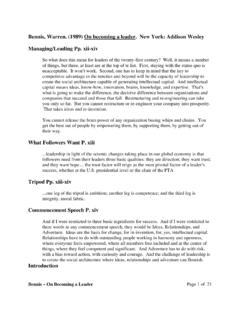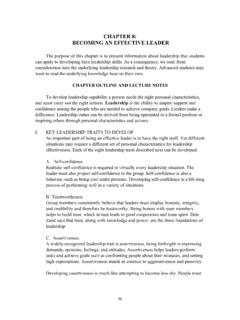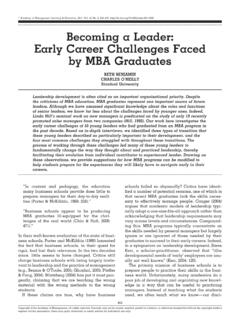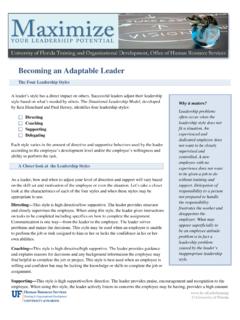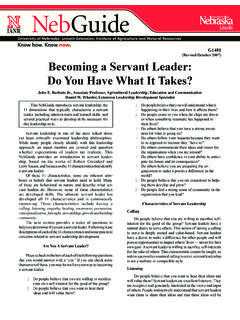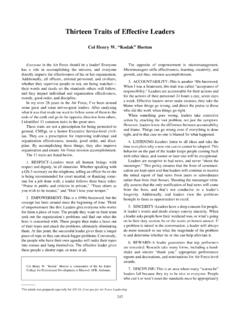Transcription of Becoming a Leader in Managing Nonprofit Human Service …
1 Becoming a Leader in Managing Nonprofit Human Service Programs Abstract Based on previous studies of a leadership development program for middle managers in Nonprofit Human Service organizations, this analysis focuses on the complexity of leadership identity formation. It features the personal characteristics and values of those working in Nonprofit Human Service organizations, the Nonprofit culture that shapes its leaders , and the process of leadership identity formation in Nonprofit organizations. It concludes with implications for developing transformative and sustainable leadership experiences for educating future leaders in Nonprofit Human Service organizations.
2 Keywords: leadership identity formation, nonprofits, Human services Becoming a Leader in Managing Nonprofit Human Service Programs INTRODUCTION Nonprofit leadership development programs provide unique learning laboratories to identify how middle managers in Human Service organizations integrate critical reflection and developmental learning processes into the practice of leading (Austin et al, 2011). Based on the training and coaching of 40 leadership development program participants in three cohorts over a three year period, it became clear that much ambivalence and tension was associated with taking on the role of Human Service manager and Leader .
3 The sources of this ambivalence and tension can be traced to multiple factors that include the participant s individual identity, the high value placed on feeling connected to clients and staff, and the clash in values found in the different subcultures within the Nonprofit Human services organizational setting. An understanding of the personal dilemmas that emerge when staff are promoted into leadership roles calls for Nonprofit Human Service organizations to develop stronger support systems. These systems include on-the job-training, mentoring and coaching as well as experiential leadership development programs that provide opportunities to experiment with the effective use of power and authority, boundary management, delegation, directing, and decision-making.
4 Without a clear understanding of the complexity involved in stepping into leadership roles in Human Service organizations, high-potential staff members can easily burn-out, refuse advancement, or leave Human services organizations. This analysis explores the complexity of developing an identity as a Leader in the Nonprofit Human services arena. The major themes are derived from the research on for-profit organizations related to identity, leadership, and leadership identity formation in order to apply them to Human services organizations; namely, 1) the importance of recognizing, and working with, the personal identity characteristics and values that employees bring with them into the organization; 2) the group/organizational culture that shapes leaders in the Human services sector; and 3) the process of leadership identity formation.
5 Learning about developing leaders The context for this analysis was a leadership development program designed for middle managers. It was built upon three pillars: 1) the concepts of organizational capacity building (Blumenthal, 2003), 2) the important differentiation between the skill-sets required to manage (planning and budgeting, organizing and staffing, controlling and problem-solving) and those required to lead (setting direction, aligning people, and motivating and inspiring) originally identified by Kotter (1990), and 3) the multiple roles of a Human Service manager (leadership, interactional, and analytic) identified by Menefee (2009).
6 Throughout the first three cohorts (40 participants) it became clear that more attention needed to be given to how leadership roles were integrated into personal identities. Participants often perceived themselves as accidental managers in terms of being recruited into managerial roles (as opposed to aspiring for advancement). These perceptions were captured in the program participants reflection papers, interviews, class discussions and case presentations as illustrated in the following examples of ambivalence and tension associated with assuming leadership roles in their respective Human Service organizations: 1) I first began to consider social work when I was twelve after reading a story about a social services worker who helped a poor impoverished mother.
7 I became fascinated by their relationship. I felt so distant from my clients when I became a manager and then a director. 2) I like envisioning the possibilities for new programs and new ways to help clients that comes with my manager role, but I find it difficult to evaluate staff performance, or hold staff accountable for performance standards. It s hard to make tough decisions and be disliked. 3) When faced with new roles, like fundraising, I find it very difficult to envision myself attending fundraising events where I need to dress-up. I can t imagine liking this part of being an Executive, as talking to wealthy people puts me in conflict with who I am and what I believe about serving poor people.
8 4) As a manager, I had to find new methods of self-care because I no longer had contact with the clients and the gratitude and recognition that come with being able to help someone better their circumstances. This array of self-reflections illustrates some of the challenges that underlie the assumption of managerial and leadership roles. These perceptions provided major challenges for participants with respect to their: 1) self-concept (how they saw themselves), 2) sense of belonging (the stakeholders they identified with, who/what gave them credibility, and how they were seen by others), 3) world view (their stories about how the world worked, how change was created, and how they wanted to participate in that process), and 4) sources of motivation (what made this promotion worthwhile, the job worth doing).
9 Similar to these perceptions, the participants in the leadership development program noted that when their agency leaders did not demonstrate effective leadership behaviors, they were considered suspect, incompetent, unfair, on the wrong track or isolated from staff perceptions ( the process wasn t fair or there wasn t enough input into a decision ). The participants in the leadership development program clearly valued relationships with leaders and authority figures when they are facilitative, non-authoritarian, and personally supportive. If these characteristics are not present, authority figures may be viewed as traumatizing and/or, in the worst case, of these perceptions, of themselves and their agency leaders led to the exploration of leadership identity formation in Nonprofit organizations.
10 LITERATURE REVIEW The mission and purpose of nonprofits are essential in attracting both Human and financial resources to the organization. However, as Hobman et al (2011) note with regard to advancement once inside a Nonprofit , the organizational mission is less important as a motivator than is an identification with, and connection to, the organization s Leader . The leadership behaviors that create connections with Nonprofit employees included: 1) supportive behavior associated with developing trust, 2) asking questions of employees and encouraging intellectual stimulation that signifies to followers that the Leader is concerned about employee welfare, growth, and development, 3) behaviors that indicate close ties to followers, and 4) personally recognizing employee contributions ( ).


